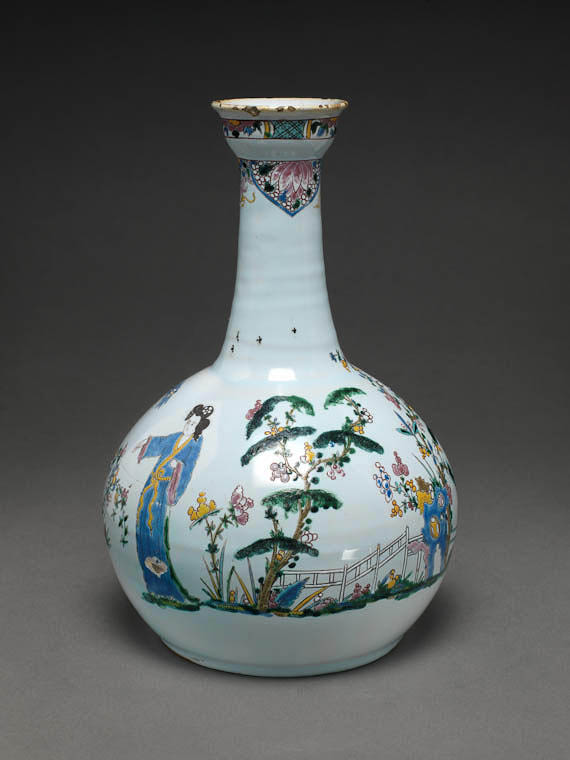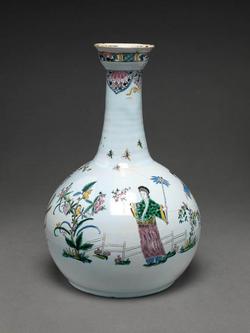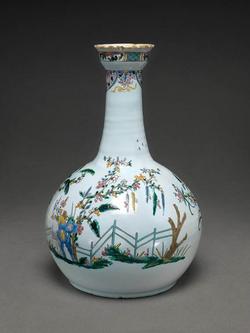Current Location: Gallery 27 (Glaisher)
Maker(s)
Production:
Unidentified Liverpool pottery
Decorator:
uncertain
(Perhaps)
Entities
Categories
Description
Tin-glazed earthenware painted in blue, green, yellow, pink, dark pink, and black enamels with two Chinese ladies standing among flowering plants
Buff earthenware, tin-glazed bluish-white, and painted overglaze in blue, green, yellow, ink, dark pink, and black enamels in famille rose style. The bottle has a bulbous lower part, a tall slender, slightly sloping neck, and a cup-shaped mouth, The bulbous part is decorated with two Chinese ladies, one of whom carries a small parasol, standing among flowering plants with a low fence behind them. Round the upper part of the neck and the cup-shaped mouth there are Oriental-style flowers and diapered panels.
Notes
History note: The Rt Hon. Sir John Eldon Gorst; sold Christie, Manson & Woods, 6 July 1916, Catalogue of Sèvres Porcelain being a portion of the collection of the late William Leveson Gower, Esq., Sen. . . . . Porcelain & Old English Furniture the property of The Right Hon. Sir John Eldon Gorst, Deceased; late of Castle Coombe Manor House, Chippenahm (Sold by Order of the Public Trustee), p. 16, lot 83; purchased for £18.18s. 0d. by Mr Stoner on behalf of Dr J.W.L. Glaisher who paid him £23.18s. 0d. including commission.
Legal notes
Dr J.W.L. Glaisher Bequest
Measurements and weight
Height: 23 cm
Height: 9 1/16 in
Width: 15.3 cm
Acquisition and important dates
Method of acquisition: Bequeathed
(1928-12-07)
by
Glaisher, J. W. L., Dr
Dating
18th Century, third quarter
George II
Circa
1750
CE
-
1760
CE
Note
The enamelled Chinoiserie decoration on this Liverpool delftware water bottle emulates the famille rose palette used on Chinese porcelain of the Yongzheng period (1723-35). It is similar in style to enamelling on some Staffordshire white salt-glazed stoneware, and it seems possible that it could have been decorated in north Staffordshire, possibly by either the Daniel or Warburton family of Hot Lane, Cobridge, who are said to have specialized in enamelling. The introduction of enamelled decoration on white salt-glazed stoneware by the early 1750s is supported by Dr Richard Pococke's account of his travels through England in 1750, 1751, and later, which mention enamelled stoneware being made in Newcastle-under-Lyme in 1750, and by the Swedish traveller, Reinhold Rücker Angerstein, who recorded seeing enamelled white salt-glazed wares at Burslem and Hanley in 1754. However, from a practical point of view it would have been easier, and safer for the objects if they had been decorated in the place where they were made, and some ceramic historians consider that this rare class of delftware (about 14 examples are recorded) was more likely to have been decorated in Liverpool. See Documentation. A comparable water bottle is in the National Gallery of Victoria, Australia, inv. no. 4543-D3.
School or Style
Chinoiserie
famille rose
People, subjects and objects depicted
Components of the work
Decoration
composed of
enamel
( blue, green, yellow, pink, dark pink, and black)
Materials used in production
bluish-white
Tin-glaze
buff
Earthenware
Techniques used in production
Throwing
: Buff earthenware, thrown, tin-glazed, and painted overglaze in blue, green, yellow, pink, dark pink, and black enamels
Tin-glazing
References and bibliographic entries
-
Catalogue of Sèvres Porcelain being a portion of the collection of the late William Leveson Gower, Esq., Sen. A pair of Chinese Mandarin Jars the property of Mrs. K.H. Gosling, Deceased; late of Wellbury, Hitchin (Sold by Order of the Executors), Porcelain & Old English Furniture the property of the Right Hon. Sir John Eldon Gorst, Deceased; late of Castle Coombe Manor House, Chippenham (Sold by Order of the Public Trustee) and from Various Sources and Five Panels of Beauvais Tapestry the property of Lieut.-Colonel the Rt. Hon. Sir WM. Carington, G.C.V.O., K.C.B., Deceased
page(s): 16
-
Catalogue of the Glaisher Collection of Pottery and Porcelain in the Fitzwilliam Museum Cambridge
page(s): 215
-
English Delftware
-
English Delftware, Engels Delfts Aardewerk
page(s): 55, 100
-
Delftware in the Fitzwilliam Museum
page(s): 225
-
Some thoughts on the outside decoration on Liverpool ceramics
page(s): 130
-
The Longridge Collection of English Slipware and Delftware, Volume 2, Delftware
page(s): 161
-
Seventeenth- and Eighteenth-century English Pottery in the Collections of the National Gallery of Victoria
page(s): 236-46
-
R.R. Angerstein’s Illustrated Travel Diary 1753-1755. Industry in England and Wales from a Swedish perspective
page(s): 310, 340, 342
-
The Travels through England of Dr Richard Pococke, successively Bishop of Meath and of Ossory during 1750, 1751 and Later Years, vol. I
page(s): 6-8
Related exhibitions
Identification numbers
Accession number: C.1727-1928
Primary reference Number: 72535
Old object number: 4680
Stable URI
Audit data
Created: Saturday 6 August 2011
Updated: Tuesday 30 April 2024
Last processed: Tuesday 15 July 2025
Associated departments & institutions
Owner or interested party:
The Fitzwilliam Museum
Associated department:
Applied Arts






